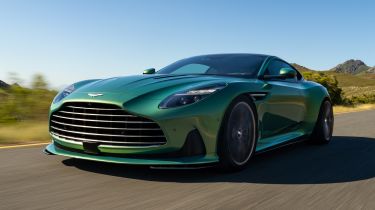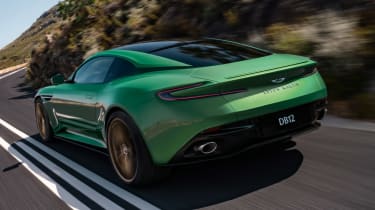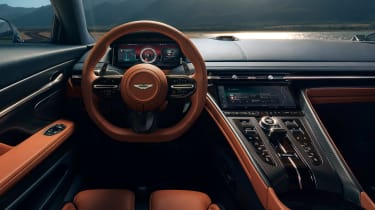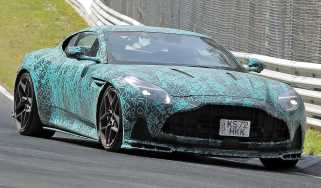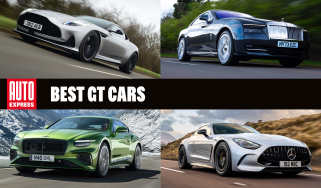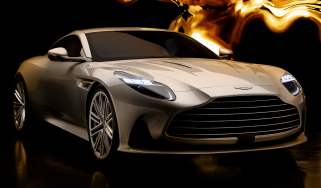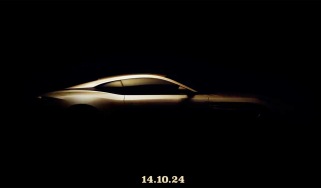New Aston Martin DB12 uncovered with 671bhp and 202mph top speed
The new Aston Martin DB12 arrives to replace the DB11 and once again features Mercedes’ 4.0-litre V8 at its heart
Aston Martin is emerging from a period of financial and managerial turmoil – and now the British luxury brand is ready to launch the first step of its bold new product line-up with the all-new DB12.
On paper, the new arrival is an evolution of the DB11 that has been a cornerstone of Aston’s line-up since 2016. But such are the increases in power and performance over that model that Aston claims the vehicle goes beyond grand tourer status to become “the world’s first super tourer”.
The DB12 does indeed share its bare underpinnings with its predecessor – but the bonded extruded-aluminium structure has been reworked, with an engine cross brace, a new front crossmember and a different rear bulkhead, to provide seven per cent more overall structural rigidity.
In addition, there’s an all-new suspension system, featuring adaptive dampers, stiffer anti-roll bars, a stability control system that uses six-axis inertia to predict the amount of available grip, and for the first time on an Aston Martin, an electronic rear differential (E-diff) that’s tuned to provide extra agility on twisty roads. The car is rear-wheel drive, of course, and features an eight-speed automatic transmission that has a shortened final drive ratio compared with the DB11’s.
Simon Newton, Aston’s Head of Vehicle Engineering, told us that the goal is to provide “traditional touring strengths but with a much broader set of abilities that deliver greater involvement on the right road. We’re confident that dynamically, this car is a huge step compared with DB11. It’s a night-and-day difference.”
At the heart of the DB12 is a totally reworked version of Aston’s Mercedes-sourced 4.0-litre twin-turbocharged V8 engine. It now produces 671bhp at 6,000rpm and 800Nm between 2,750rpm and 6,000rpm, enough to take the DB12 from 0-60mph in 3.5 seconds and on to a top speed of 202mph. That makes the car almost half a second quicker to 60mph than the DB11, and gives it a 10mph higher top speed.
There’s no word yet on a V12 version, incidentally. Aston is focused on investing in V8 power for the time being, and it’s possible that it may restrict its twin-turbo V12 – most recently upgraded for last year’s DBS 770 Ultimate – to limited-run models that sit above the DB12 in its range.
Other technical features include 21-inch forged-alloy wheels as standard, Michelin Pilot Sport 5 tyres with a bespoke compound – the first time this rubber has been fitted by a manufacturer – and a mix of 400mm (front) and 360mm (rear) brake discs. Carbon-ceramic items, which save 27kg in unsprung mass, will be offered as an option.
The DB12’s design, penned under the direction of Marek Reichmann, is unmistakably Aston GT, while marking a clear step compared with the DB11. It shares its same basic dimensions with that car – around a centimetre shorter, a couple of centimetres taller and precisely the same width – but has wider track (by 6mm at the front, 22mm at the rear) and a much more dramatic front end. It has a larger radiator grille, new daytime-running lights and more sophisticated surfacing. The DB12 is also the first Aston to feature a revised version of its ‘wings’ badge.
The flanks are dominated by muscular rear haunches, although the overall look is extremely clean and uncluttered, including flush door handles that present themselves to the owner as they approach the vehicle.
Arguably the biggest step of all comes in the cabin, where the DB12 gets a sorely needed tech makeover. Out goes the ageing Mercedes-sourced infotainment, replaced by Aston’s first ever bespoke set-up. Developed in house, the system has a 10.25-inch high-res screen incorporating wireless Android and Apple connectivity, as well as its own navigation software.
Aston says it has worked hard on the balance between physical and screen-based controls. All of the key mechanical functions – gear selection, drive-mode selection, heating and ventilation, the chassis settings and the switchable exhaust – get their own buttons in the centre console. The screen, meanwhile, is the vehicle’s link to the outside world, not only through over-the-air updates but also via Aston’s own smartphone app, which allows users to monitor the vehicle and send it navigation instructions ahead of a journey.
There’s a high centre console – ensuring that you feel like you’re sitting in the DB12 instead of on it – and elements like the fully digital instrument panel sit alongside crafted elements like Bridge-of-Weir leathers on the seats and door panels. Other interior features include a standard 11-speaker audio system and, as an option, a 15-speaker, double-amplified 1,170-watt hi-fi developed in conjunction with Bowers & Wilkins. The boot capacity is 262 litres, slightly down on the DB11’s figure.
Advanced previews of the DB12 are likely to have earned Aston an early order bank; the company says first deliveries should start in the autumn. No prices have been announced but given the extra technologies and features on board, we’d expect a bump up from the DB11’s starting figure, to around £190,000.
Click here for our list of the best supercars on sale right now...
Find a car with the experts

